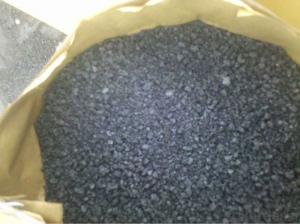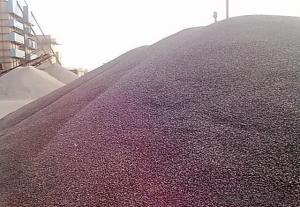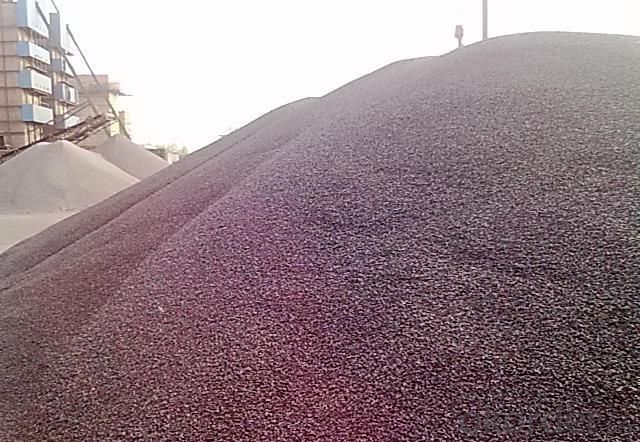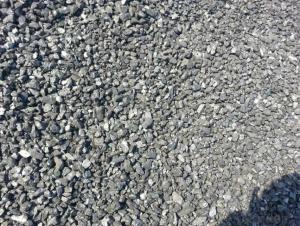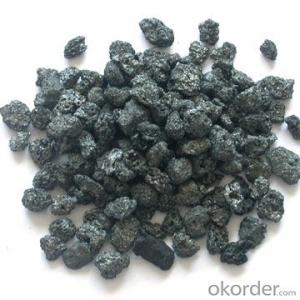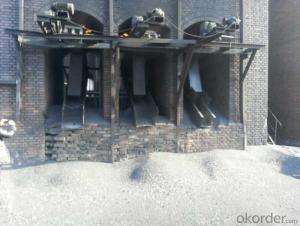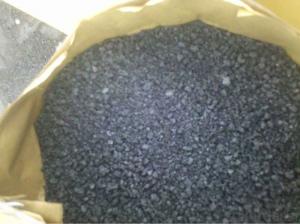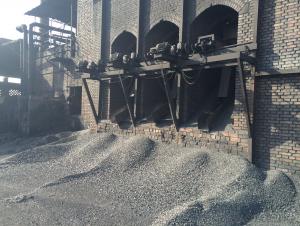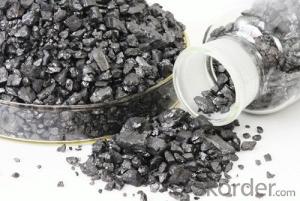FC90 Gas Calcined Anthracite/CNBM GCA China Product
- Loading Port:
- Tianjin
- Payment Terms:
- TT OR LC
- Min Order Qty:
- 0 m.t.
- Supply Capability:
- 100000 m.t./month
OKorder Service Pledge
OKorder Financial Service
You Might Also Like
Packaging & Delivery
| Packaging Detail: | 25kgs/50kgs/1ton per bag or as buyer's request |
| Delivery Detail: | Within 20 days after receiving corect L/C |
Feature
All of our goods are made in the best quality of world famous Tianjin. All of our products are with High carbon, Low ash, low sulphur, Low Moisture.
Usage
The Calcined Anthracite Coal/Gas Calcined Anthracite Coal/Carbon Raiser is mainly used in steelmaking in electrical stove, screening water, shipbuilding sandblast to remove rust. It can reduce the cost of steelmaking effectively by replacing the traditional petroleum coke of carburant.Also can improve the Carbon content in steel-melting and Ductile iron foundry.
Specifications
Calcined Anthracite
Fixed carbon: 90%-95%
S: 0.5% max
Size: 0-3. 3-5.3-15 or as request
PARAMETER UNIT GUARANTEE VALUE | |||||
F.C.% | 95MIN | 94MIN | 93MIN | 92MIN | 90MIN |
ASH % | 4MAX | 5MAX | 6MAX | 7MAX | 8MAX |
V.M.% | 1 MAX | 1MAX | 1.5MAX | 1.5MAX | 1.5MAX |
SULFUR % | 0.5MAX | 0.5MAX | 0.5MAX | 0.5MAX | 0.5MAX |
MOISTURE % | 0.5MAX | 0.5MAX | 0.5MAX | 0.5MAX | 0.5MAX |
Size can be adjusted based on buyer's request.
Picture

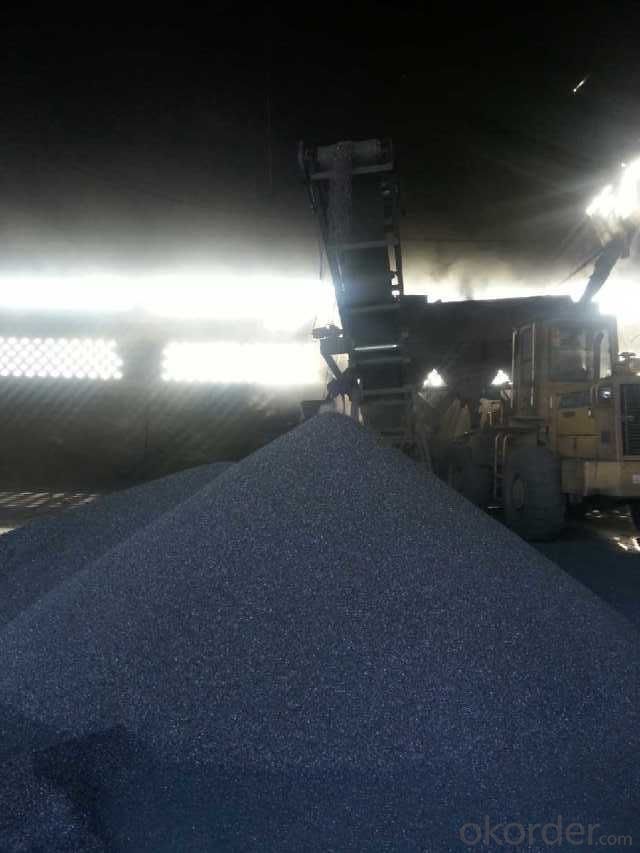
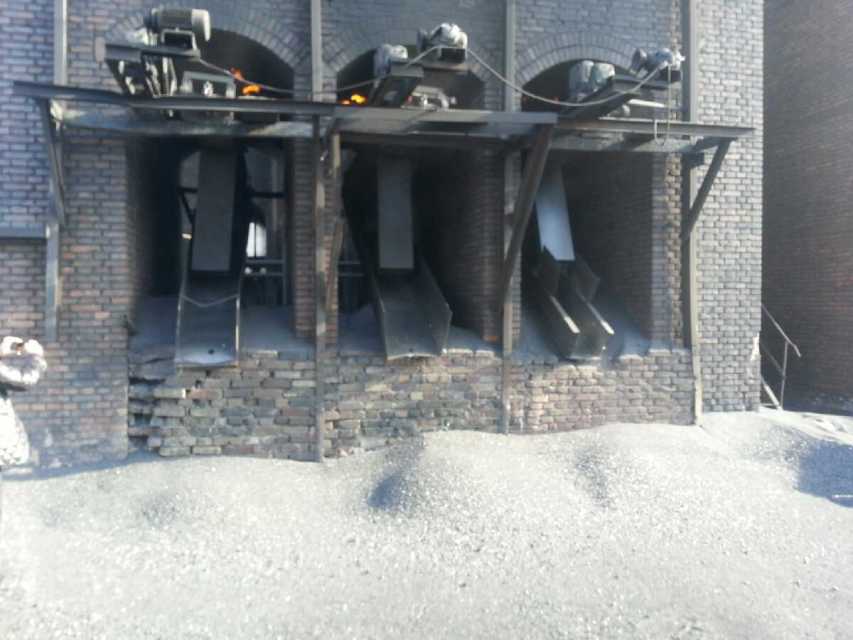
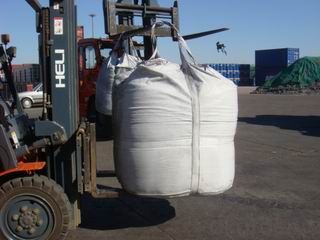
We can supply below furnace charges, please feel free to contact us if you areinterested in any of any of them:
Coke (Metallurgical, foundry, gas)
Calcined Anthracite with fixed carbon from 90% to 95%
Calcined Petroleum Coke
- Q: I heard that 85 of the furnace rock carbon harmony, and the result that I use advanced strengthening machine when I want to give high-grade furnace rock carbon, this how ah?
- You can charge for advanced carbon, without consuming advanced carbon or advanced strengthening1., first of all, point to strengthen the advanced equipment, he will come out of a fortified box, point strengthening, it will come out a small hand, then ignore the reinforcement box, and drag it aside.2. click Kelly again. Point hardening equipment. (note! Not to reinforce advanced equipment.)! That's OK. Then, you have to reinforce your weapon over +10.
- Q: What are the environmental impacts of carbon emissions?
- Carbon emissions have a range of significant environmental impacts. One of the most pressing issues is the contribution to climate change. Carbon dioxide (CO2) is a greenhouse gas that traps heat in the Earth's atmosphere, leading to a rise in global temperatures. This increase in temperature has far-reaching consequences, including melting polar ice caps, rising sea levels, and more frequent and intense extreme weather events such as hurricanes, droughts, and floods. Another environmental impact of carbon emissions is ocean acidification. When CO2 is released into the atmosphere, a portion of it dissolves into the oceans, forming carbonic acid. This acidification disrupts the pH balance of the ocean, which is vital for the survival of marine life. It negatively affects the growth and development of coral reefs, shellfish, and other organisms that rely on calcium carbonate to build their shells or skeletons. Furthermore, carbon emissions contribute to air pollution. The burning of fossil fuels releases not only CO2 but also other pollutants such as nitrogen oxides (NOx), sulfur oxides (SOx), and particulate matter. These pollutants have detrimental effects on air quality, leading to respiratory problems, cardiovascular diseases, and other health issues for both humans and animals. Additionally, they contribute to the formation of smog and haze, reducing visibility and further degrading air quality. Carbon emissions also have indirect impacts on ecosystems. The alteration of climate patterns can disrupt ecosystems and affect the distribution and behavior of various species. This can lead to changes in the migration patterns of birds, the timing of plant flowering, and the availability of food sources. These disruptions can have cascading effects on entire ecosystems, potentially leading to the extinction of certain species or the invasion of non-native species. Lastly, carbon emissions contribute to the depletion of natural resources. The extraction and burning of fossil fuels for energy production not only release carbon dioxide but also require the destruction of habitats and ecosystems. This includes mining for coal, drilling for oil, and deforestation for palm oil plantations or grazing lands. These activities result in the loss of biodiversity, destruction of habitats, and soil erosion, further exacerbating environmental degradation. In conclusion, the environmental impacts of carbon emissions are diverse and far-reaching. They include climate change, ocean acidification, air pollution, disruption of ecosystems, and the depletion of natural resources. Addressing these impacts requires a concerted effort to reduce carbon emissions and transition towards cleaner and more sustainable energy sources.
- Q: Glucose contains resveratrol (C14H12O3) to determine the mass ratio of resveratrol and carbon dioxide of the same quality as carbon dioxide
- They are x and y, containing carbon equal, according to the mass of an element = the mass of a compound * the elementMass fractionFor C14H12O3, the carbon mass fraction is C%=12*14/ (12*14+12+16*3) *100%=73.68%For CO2, the mass fraction of carbon is 12/ (12+16*2) =27.27%There is x *73.68%=y*27.27%So there's X: y =57:154
- Q: What are the impacts of carbon emissions on the spread of infectious diseases?
- Carbon emissions have a significant impact on the spread of infectious diseases. The burning of fossil fuels, such as coal, oil, and natural gas, releases large amounts of carbon dioxide (CO2) and other greenhouse gases into the atmosphere. These emissions contribute to climate change, which in turn affects the distribution and transmission of various infectious diseases. One of the main ways carbon emissions influence the spread of infectious diseases is through changes in temperature. Rising global temperatures create favorable conditions for the survival and proliferation of disease-causing agents and their vectors. For example, warmer temperatures can expand the geographic range of disease-carrying insects like mosquitoes, which are responsible for transmitting diseases such as malaria, dengue fever, and Zika virus. Additionally, climate change caused by carbon emissions can disrupt ecosystems and alter the behavior of animals that serve as hosts or reservoirs for infectious diseases. Changes in migration patterns, breeding cycles, and hibernation can affect the dynamics of diseases, making them more difficult to control. For instance, warmer temperatures may lead to the expansion of tick populations, increasing the risk of tick-borne diseases like Lyme disease. Furthermore, carbon emissions contribute to air pollution, which has adverse effects on respiratory health. Pollutants like particulate matter and nitrogen dioxide can weaken the immune system and make individuals more susceptible to respiratory infections, including influenza and pneumonia. These pollutants also exacerbate the severity of respiratory symptoms in individuals already infected with respiratory diseases. The impacts of carbon emissions on the spread of infectious diseases are not limited to direct effects on humans. Changes in climate patterns can disrupt agricultural systems, leading to food insecurity and malnutrition. These conditions weaken the immune systems of vulnerable populations, making them more susceptible to infectious diseases. It is important to recognize the connection between carbon emissions and the spread of infectious diseases in order to mitigate their impacts. Reducing carbon emissions through transitioning to cleaner energy sources and implementing sustainable practices can help mitigate climate change and limit the expansion of disease vectors. Additionally, investing in public health infrastructure and surveillance systems can enhance our ability to detect and respond to outbreaks, minimizing their spread and impact on human populations.
- Q: What are the different types of carbon-based plastics?
- Carbon-based plastics come in various types, each possessing distinct characteristics and uses. Among the commonly known variants are: 1. Polyethylene (PE): This plastic, available in high-density polyethylene (HDPE) and low-density polyethylene (LDPE) forms, is widely employed due to its strength, flexibility, and resistance to chemicals. It finds applications in packaging, pipes, and toys. 2. Polypropylene (PP): Renowned for its high melting point, chemical resistance, and durability, PP is a popular choice for automotive parts, appliances, and packaging. 3. Polystyrene (PS): PS, a rigid plastic, frequently features in disposable products like food containers and packaging materials. Its lightweight nature and good insulation properties make it advantageous. 4. Polyvinyl Chloride (PVC): PVC, a versatile plastic that can be flexible or rigid based on its composition, sees wide usage in construction materials, pipes, cables, and vinyl flooring. 5. Polyethylene Terephthalate (PET): PET, a lightweight and sturdy plastic, is commonly employed in beverage bottles, food packaging, and textile fibers. It is renowned for its exceptional resistance to gas and moisture. 6. Polycarbonate (PC): PC, a transparent plastic, stands out for its high resistance to impact and heat. It is often utilized in eyewear, automotive parts, and electronic devices. These examples represent just a fraction of the carbon-based plastics available in the market. Numerous other variations and blends exist, and the choice of plastic depends on factors such as intended application, desired properties, and environmental considerations.
- Q: How is carbon used in the production of paints and coatings?
- Carbon is used in the production of paints and coatings in several ways. Firstly, carbon black is a common pigment used in paints and coatings to provide color and opacity. It is made by burning natural gas or oil in a controlled environment, resulting in fine particles of carbon. Carbon black enhances the color intensity and durability of the paint or coating, as well as improves its resistance to UV light and weathering. Additionally, carbon-based compounds, such as resins and polymers, are used as binders in the formulation of paints and coatings. These binders help hold the pigment particles together and adhere them to the surface being painted or coated. Carbon-based binders are known for their excellent adhesion properties, which contribute to the durability and longevity of the paint or coating. Furthermore, carbon nanotubes are increasingly being used in the production of high-performance paints and coatings. These nanotubes, which are cylindrical carbon structures, have exceptional mechanical, thermal, and electrical properties. They can be incorporated into paint or coating formulations to enhance their strength, conductivity, and resistance to corrosion or abrasion. In summary, carbon plays a crucial role in the production of paints and coatings. It is used as a pigment to provide color and opacity, as binders to hold the pigment particles together, and as carbon nanotubes to enhance the performance and functionality of the final product.
- Q: What is carbon nanoelectronics?
- Carbon nanoelectronics refers to the field of research and development that focuses on utilizing carbon-based materials, such as carbon nanotubes or graphene, for the creation and advancement of electronic devices and components on a nanoscale level. These nanoscale carbon structures possess unique electrical properties that make them highly desirable for applications in a wide range of electronic devices, including transistors, sensors, and interconnects. One of the key advantages of carbon nanoelectronics is the exceptional electrical conductivity and thermal properties of carbon nanomaterials. Carbon nanotubes, for instance, exhibit excellent electrical conductivity, comparable to copper, but with a much smaller footprint. This property allows for the creation of smaller and more efficient electronic devices, leading to advancements in areas such as miniaturization and energy efficiency. Another noteworthy aspect of carbon nanoelectronics is the immense strength and flexibility of carbon nanomaterials. Carbon-based structures like graphene possess exceptional mechanical properties, making them highly durable and resilient. This property enables the production of flexible and wearable electronic devices that can conform to various surfaces, opening up new possibilities for electronics design and integration. Additionally, carbon nanoelectronics offers the potential for high-speed and low-power electronic devices. The unique electronic properties of carbon nanomaterials, such as their ability to carry electric charge at an extremely high speed, make them suitable for high-frequency applications. Furthermore, the low power consumption of carbon nanomaterials can lead to the development of energy-efficient electronic devices. Overall, carbon nanoelectronics holds great promise for revolutionizing the field of electronics by enabling the creation of smaller, faster, and more energy-efficient devices. Continued research and development in this field are expected to lead to breakthroughs in various industries, including computing, telecommunications, healthcare, and energy.
- Q: What is the composition of carbon in stainless steel?
- (7) chromium can improve the hardenability and wear resistance of steel, and can improve the corrosion resistance and oxidation resistance of steel(8) vanadium; can refine the grain size of steel, improve the steel strength, toughness and wear resistance. When it is in the high temperature melt into austenite, can increase the hardenability of steel; on the contrary, when it is in the form of carbide exists, it will reduce the hardenability.(9) molybdenum can obviously improve hardenability and heat resistance of steel, prevent temper brittleness, and increase residual magnetism and attractive force(10) titanium can refine the grain structure of steel so as to improve the strength and toughness of steel. In stainless steel, titanium can eliminate or mitigate intergranular corrosion of steel(11) nickel can improve the strength and toughness of steel, and improve the hardenability. When the content is high, it can significantly change some physical properties of steel and alloy, and improve the corrosion resistance of steel(12) boron; when the steel contains a trace of (0.001 - 0.005%) boron, the hardenability of steel can be doubled and raised(13) aluminum can refine the grain structure of steel, restrain the aging of low carbon steel, improve the toughness of steel at low temperature, and can also improve the oxidation resistance of steel, improve the wear resistance and fatigue strength of steel(14) copper; its outstanding function is to improve the atmospheric corrosion resistance of ordinary low alloy steel, especially when used in combination with phosphorus
- Q: What are the applications of carbon nanowires?
- Carbon nanowires have numerous applications in various fields. They are used in electronics for creating high-performance transistors, sensors, and conductive electrodes. Their exceptional mechanical properties make them suitable for reinforcement materials in composites, such as lightweight and strong materials for aerospace and automotive industries. Carbon nanowires also find applications in energy storage devices like batteries and supercapacitors, as well as in biomedical engineering for drug delivery systems and tissue engineering scaffolds.
- Q: What is the difference between carbon nanomaterials and nano carbon materials?
- Carbon nanomaterials are a general term for carbon nanotubes, carbon nanofibers, and so on. Therefore, there are differences and connections between these two statements.
Send your message to us
FC90 Gas Calcined Anthracite/CNBM GCA China Product
- Loading Port:
- Tianjin
- Payment Terms:
- TT OR LC
- Min Order Qty:
- 0 m.t.
- Supply Capability:
- 100000 m.t./month
OKorder Service Pledge
OKorder Financial Service
Similar products
Hot products
Hot Searches
